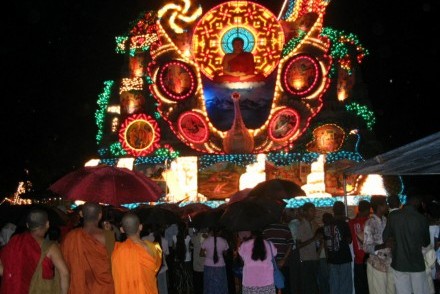TikaWeeks #17/2018: Sri Lanka update
Posted by John on 29th April 2018

Wesak – Vesākha, Buddha Purnima or Buddha’s Birthday
Today (29 April 2562, in the Buddhist calendar) is the full moon of Wesak (pronounced “vay-sack”), which is the most important Buddhist festival of the year. It commemorates the Birth, Enlightenment (Buddhahood) and Parinirvana (death) of Gautama Buddha of the Theravada tradition, which are believed to have taken place on this day. Devotees go to the temple, offer gifts to the monks and listen to their sermons. Lanterns made of clay or paper are lit in front of the house, and towns and villages have platforms (pandals) decorated with scenes of the life of the Buddha. It always falls on the full moon of the month of Vesākha in April or May and it is a public holiday traditionally observed by Buddhists and some Hindus on different days in Sri Lanka, India, Nepal, Tibet, Bangladesh, Bhutan, Indonesia, Singapore, Thailand, Cambodia, Laos, Malaysia, Myanmar, Mongolia and the Philippines and in China, Japan, South Korea, North Korea, Taiwan and Vietnam as well as in other parts of the world.
On Vesākha, devout Buddhists and followers alike assemble in their various temples before dawn for the ceremonial and honourable hoisting of the Buddhist flag and the singing of hymns in praise of the holy “Triple Gem”: The Buddha, The Dharma (his teachings), and The Sangha (his disciples). Devotees may bring simple offerings of flowers, candles and joss-sticks to lay at the feet of their teacher. These symbolic offerings are to remind followers that just as the beautiful flowers would wither away after a short while and the candles and joss-sticks would soon burn out, so too is life subject to decay and destruction. Devotees are enjoined to make a special effort to refrain from killing of any kind. They are encouraged to partake of vegetarian food for the day.
In Sri Lanka, two days are set aside for the celebration of Vesākha and all liquor shops and slaughter houses are closed by government decree during these two days. Electrically-lit pandals called thoranas are erected around the country, mainly in Colombo, Kandy, Galle and Anuradhapura, most sponsored by donors, religious societies and welfare groups. Each pandal illustrates a story from the Jataka tales, a voluminous body of literature native to India concerning the previous births of Gautama Buddha in both human and animal form. In addition, colourful lanterns called Vesak kuudu are hung along streets and in front of homes, signifying the light of the “Triple Gem”. Food stalls set up by Buddhist devotees called dansälas provide free food and drinks to passers-by. Groups of people from community organisations, businesses and government departments sing bhakti gee (Buddhist devotional songs).
A Day in the Life of Sri Lanka – #1 A simple, austere life
Despite the industrialisation policy adopted by successive governments, the vast majority of the Sri Lankan population works in agriculture. Work in the fields or in the fisherman's villages makes up the daily life of three-quarters of the island's inhabitants, while urban life is essentially concentrated around Colombo with its population of 2 million.
The villagers of the Sri Lankan countryside are very hospitable and the air of equality and dignity is very different from the social tensions that haunt the city. Life is often frugal and not always easy in the country. There are still families living below the poverty line, working tiny plots of land. Usury is common practice, because more than a quarter of farmers do not own their land and have to give half the produce from the fields they farm to their sponsors. Monthly earnings average about US$90 when the monsoon is kind. At this level, every rupee counts. Enough has be put aside for seed, fertiliser or renting agricultural machinery, and enough must be produced to ensure a daily minimum ration of a kilogramme of rice for a family of four people. Many families count on supplementary revenue by sending one of their members to work as a salaried employee in the plantations in the centre of the island or a garment factory around Colombo, or by choosing to go and settle on one of the new areas of colonised land in the dry zone.
Where to stay in… Kandy
The Kandy House is a charming and an historic heritage walauwa (manor house) dating back to 1804 and tastefully refurbished to exceptionally high standards. This stunning manor house is truly romantic, particularly as it accepts guests over 12 years of age only! All rooms are individually designed, and lush gardens with a secluded forest pool envelope the property, which is renowned for its cuisine.
Hanthana House is a guesthouse with a difference. This family home offers a comfortable stay in attractive surroundings with the added benefit of tasty and authentic Sri Lankan home cooking! Hanthana House is located in the Hanthana Hills, an area famous for cultivating some of the first tea grown on the island.
Ellerton was built over 100 years ago for the manager of a major tea plantation in the area and, although it has been refurbished and expanded, the property still preserves the character and tranquillity of bygone colonial days with a relaxed ’country house’ atmosphere. Situated at 725 metres above sea level and immersed in the verdant Sri Lankan countryside, it has spectacular views of the surrounding area from the verandas, well-tended gardens and swimming pool.
Categories: Accommodation, Culture, Honeymoon, Sightseeing, Sri Lanka
« All articles




